Scalability Challenges
Monolithic vs. modular blockchain
Exploring emerging design spaces within the blockchain technology landscape.
Written by Mustafa Bedawala. Acknowledgement to Catherine Gu, Eduardo Lopez, Mert Ozbay and Aaron Salot
06/22/2023
Blockchain technology is emerging as a revolutionary tool, redefining the landscape of digital systems with its promise of decentralization, transparency and open-source nature. The capacity of this technology to significantly impact businesses worldwide is increasingly evident. Various industries, from finance and payments to supply chain management, are harnessing and continuously exploring new blockchain applications. In finance, it's transforming the way transactions are conducted; in supply chain management, it's offering unprecedented traceability, and in payments, it's removing geographical barriers and expediting processes. Find out what use cases enterprises are exploring with blockchain in our latest publication, "A Comprehensive Overview of Enterprise Blockchain." ¹
Public blockchains incentivize validators, who are self-interested parties responsible for recording transactions on the blockchain. However, the mechanism for maintaining these incentives can lead to congestion and high fees, prompting the adoption of alternative blockchains that may prioritize higher transaction limits over security and decentralization. Additionally, variations in blockchain designs help contribute to fragmentation in the blockchain space. To help achieve optimal performance, scalability and flexibility, a blockchain's architecture and design are critical. In efforts to combat the scalability issues that blockchains face, developers can employ modularity, which is an architectural design approach that can help enhance flexibility and efficiency by breaking down a blockchain into smaller, independent components that can be easily replaced, upgraded or extended. Modularity thus allows developers to create more efficient, flexible and customizable blockchain applications. However, achieving modularity necessitates balancing trade-offs between scalability, security and decentralization. This complex problem requires developers, investors and users to understand the spectrum of modularity in blockchain design.
As blockchain technology continues to gain momentum and new value transfer networks emerge, it becomes essential to analyze and understand the wide range of design possibilities in the blockchain industry. This includes exploring various blockchain types, consensus mechanisms, levels of decentralization and architectural decisions that comprise the industry's design landscape. Therefore, a thoughtful approach to blockchain design is crucial, one that carefully considers the complexities and trade-offs involved. In this article, we will delve into the concept of modularity in blockchain design and examine various blockchain architectures to broaden our understanding of this aspect. We will discuss the unique characteristics and features of each category and analyze their potential impact on the development and adoption of blockchain systems.
The blockchain trilemma
Public blockchain networks use decentralized consensus mechanisms to achieve data consensus across a network of nodes, offering transparency, equitable access and protection against external threats. Nevertheless, achieving comprehensive security across a decentralized network that can also handle high transactional throughput represents a significant challenge for blockchain technology.
The blockchain trilemma,² also known as the scalability trilemma, highlights the tradeoffs that public blockchains must make between security (strong consensus and immutability), decentralization (widespread distribution of network control) and scalability (capacity to handle a higher volume of transactions). Given these tradeoffs, achieving all three characteristics simultaneously is improbable. Protocol changes, such as node requirements, block size and speed upgrades, require compromises between these three essential attributes.
Figure 1 - The Blockchain Scalability Trilemma
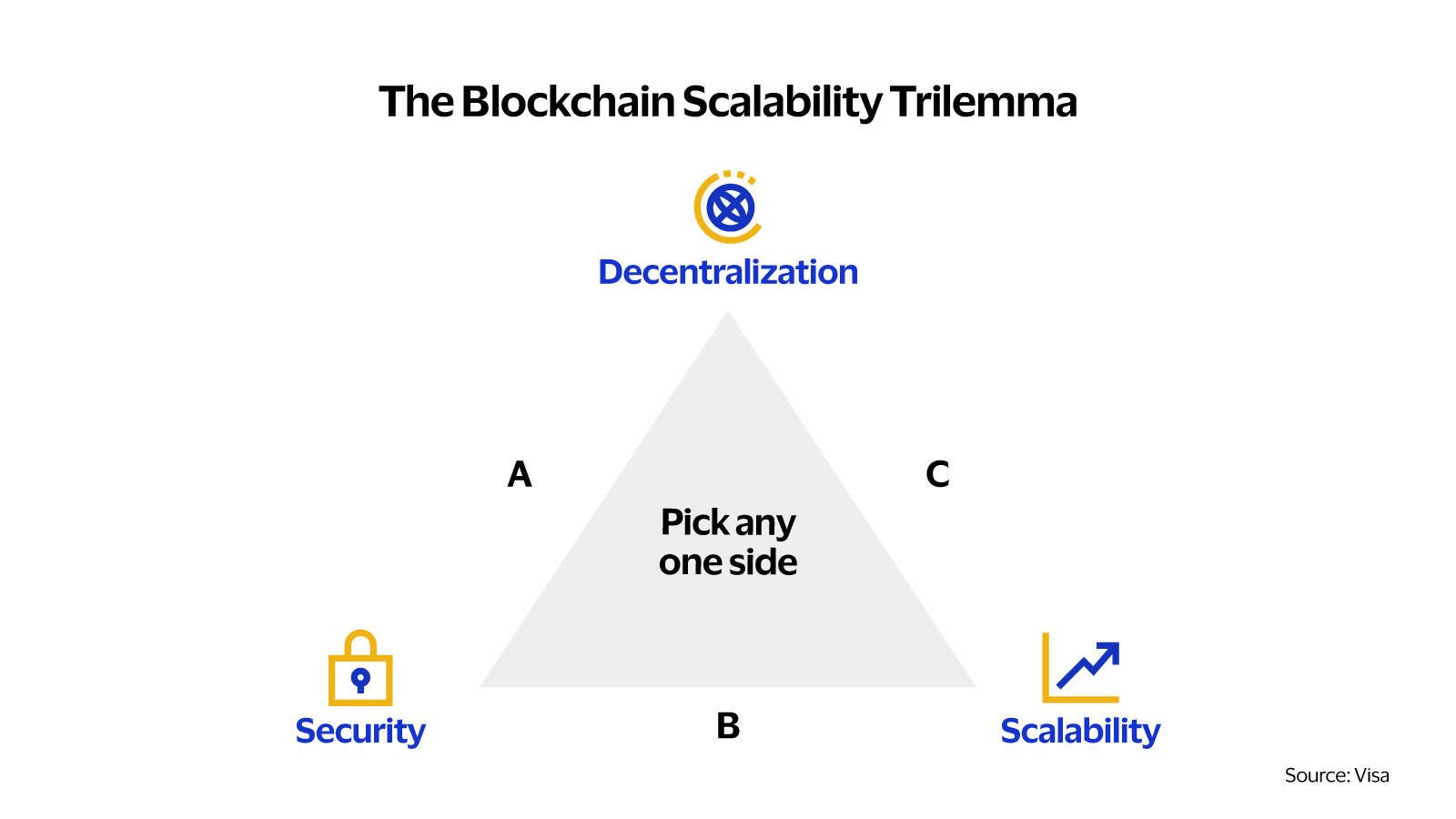
- Decentralized blockchains tend to be secure because there is a low likelihood that a single party or small group can manipulate the blockchain and the consensus is robust. However, they may suffer from lower throughput due to their lack of scalability. This is the case with traditional blockchains like Bitcoin and Ethereum (prior to the introduction of data sharding).
- Conversely, if a blockchain is scalable and secure, it is likely not decentralized, as it requires substantial hardware validator requirements for faster transaction processing and communication. This necessitates more expertise and funds, limiting the number of entities that can operate nodes and reducing the blockchain's decentralization.
- Finally, if a blockchain is both scalable and decentralized, it may face security risks due to a lack of interoperability standards, as observed in multi-chain ecosystems. In a scalable and decentralized blockchain, nodes are designed to be easy to set up and operate, with the goal of handling transactions and communication for consensus at a high rate. However, network latency can result in communication delays, which in turn create opportunities for attacks that disrupt consensus and put the blockchain's security at risk.
Striking the right balance between these three factors is crucial for the growth and adoption of blockchain technology. As the technology evolves, different layers of networks are emerging, and there is a movement toward modularizing the blockchain stack to overcome the blockchain trilemma. In the subsequent sections, we will delve into the differences between monolithic and modular blockchain designs and examine how each approach aims to address this challenge.
Four essential components of blockchain technology
Figure 2 - Component of Blockchain Stack
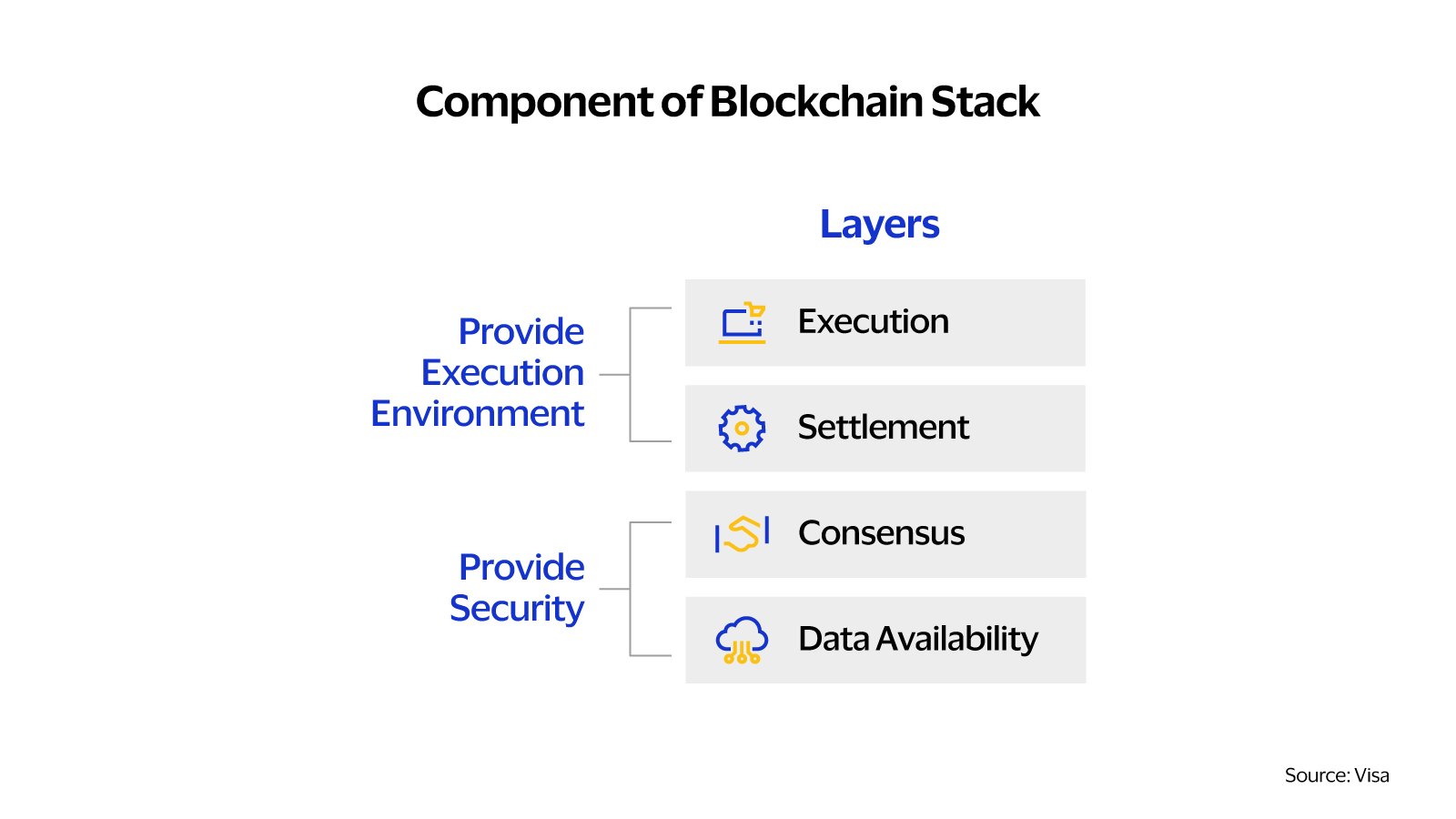
- Execution: Execution is the process in which blockchain nodes process transactions to transition between states. Before validating blocks, nodes participating in consensus must execute transactions using their copy of the blockchain. This layer enables users to engage with the blockchain by signing transactions, executing smart contracts and transferring assets.
- Settlement: Settlement is the process that ensures transaction immutability on the blockchain, playing a critical role in guaranteeing that no one can alter recorded transactions. Often considered the "anchor" within the blockchain's layers, settlement provides finality or irreversibility. To achieve this, the blockchain must validate transactions, confirm proofs and resolve disputes.
- Consensus: Consensus is a process that establishes a shared agreement on the validity of transactions. The consensus component functions by creating a system of ordering and finality, achieved through a network of full nodes that download and execute block content. These nodes collaborate to reach a consensus on the validity of state transitions, which helps to determine the network's shared state at any given moment.
- Data availability: Data availability is the process that ensures access to requested data within the blockchain. Block producers must publish transaction data for network peers to download and store. This guarantees the accessibility of transaction data, essential for the proper functioning of the blockchain.
Take, for example, a scenario where Alex sends an ERC-20 token to Rosetta. In this case, the smart contract governing the token's transfer is executed through the execution component. The settlement component, however, is equally important, as it provides Rosetta with the assurance of finality and immutability, confirming the transaction's irreversibility. The consensus component comes into play when all nodes need to agree on the transaction's legitimacy and establish its position in relation to other transactions that could influence the payment outcome. Finally, the data availability component is responsible for storing the transaction data after its completion, enabling participants to verify it against historical records at a later date. This example applies to all blockchain designs. In modular blockchains, developers can assign different layers to various types of blockchains, while in monolithic ones, all layers form a single, unified blockchain stack, which we will discuss next.
Understanding monolithic and modular blockchain design
Selecting the appropriate blockchain architecture for a project requires a thorough evaluation of the trade-offs between monolithic and modular designs. Monolithic blockchains present certain advantages, such as robust security and decentralization, which help deter malicious actors from disrupting the system. In contrast, modular blockchains are specifically designed for efficient execution and may be especially well-suited for peer-to-peer (P2P) payment applications that require cost-effective and rapid operations. In modular blockchains, various scaling approaches exist, with some compromising on one aspect of the trilemma while others build upon a base layer for scalability.
Monolithic
In a monolithic blockchain, all tasks are carried out on a single layer or a cluster of closely interconnected chains that operate on the same layer. Nodes in a monolithic chain are responsible for executing consensus, ensuring data availability and validating transactions. As a result, these nodes simultaneously serve all four core blockchain functions.
Figure 3 - Layers of Monolithic Chains
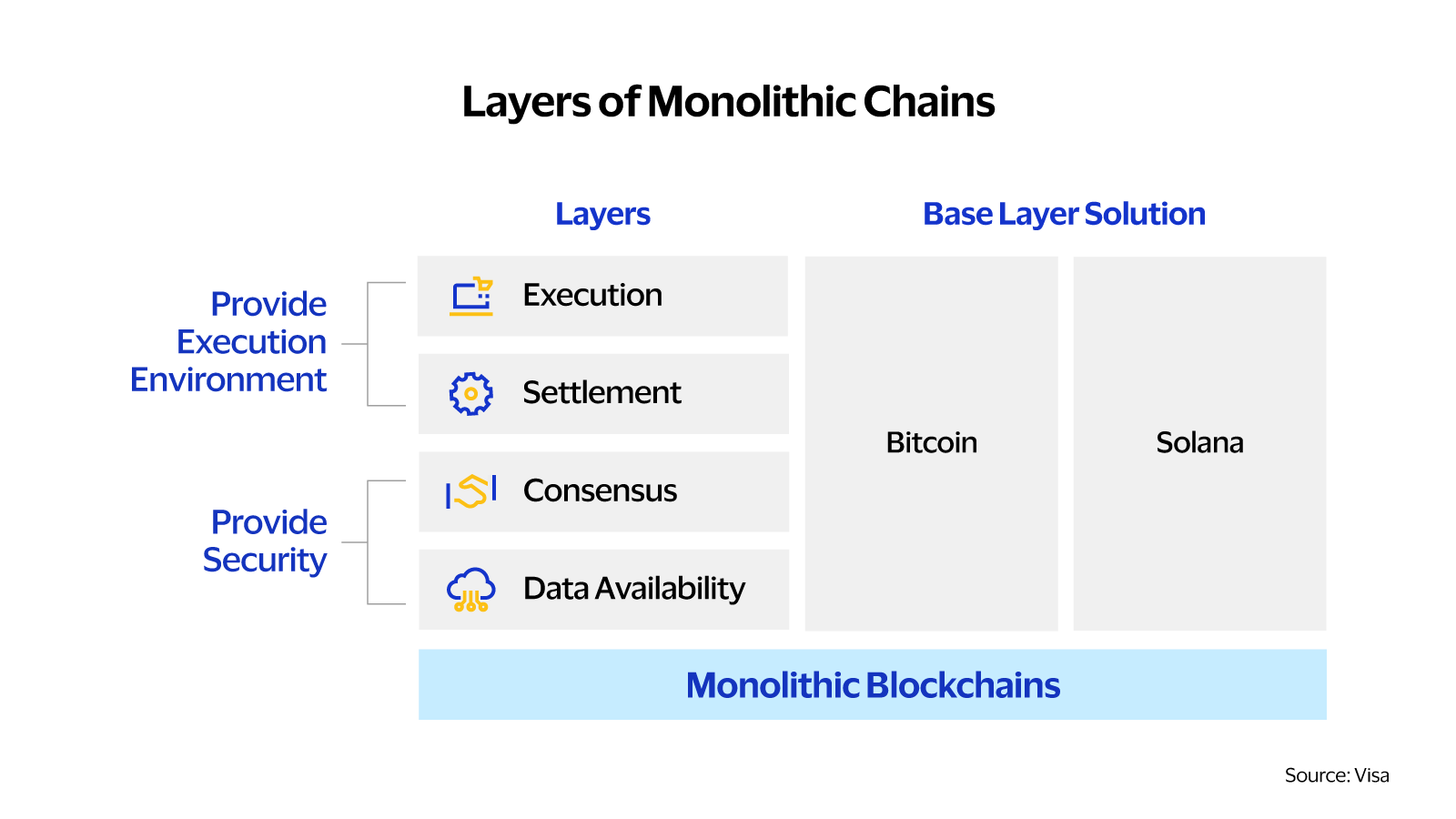
For example, Bitcoin, the first-ever monolithic blockchain, requires nodes to process every block using their own copy of the blockchain. Nodes are computers within the network responsible for validating and relaying transactions. This approach enhances Bitcoin's security and decentralization but makes it challenging to handle high transaction volumes or accommodate more users.³
Prior to the data sharding upgrades detailed in its roadmap, Ethereum's current design optimizes for a secure and decentralized network with limited scalability. It features 12-second block times and targets a long-term equilibrium of 15M gas per block, with a hard cap of 30M gas per block. By prioritizing security and decentralization, Ethereum has become the most durable and popular smart contract platform. However, this comes at the cost of high and volatile transaction fees, which can negatively impact user experience, particularly when the network is in high demand, such as during an NFT mint.⁴
Additionally, Solana is a monolithic chain that unifies execution, data availability and consensus in a single location. In contrast to Ethereum, Solana prioritizes scalability, necessitating that participants operate high-performance validator nodes capable of processing thousands of transactions per second.⁵
Modular
Modular blockchains are composed of interconnected modules or components, each responsible for specific functions. This approach streamlines system development, testing and maintenance while enhancing flexibility and scalability. By unbundling each component, blockchains can optimize each and create a product where the whole is greater than the sum of its parts. A modular blockchain manages only a few focused tasks, delegating the rest to separate layers. This design is grounded in specialization, where each component excels in a limited set of tasks. Modular blockchains form essential parts of a larger "modular stack" of blockchains that developers can combine to achieve specific objectives. These blockchains act as "pluggable modules" that developers can replace or merge depending on the use case. Among the many modular methods are the few below that are most widely discussed and researched in the rollup-centric ecosystem, showcasing different implementation approaches.
Figure 4 - Layers of Modular Chains
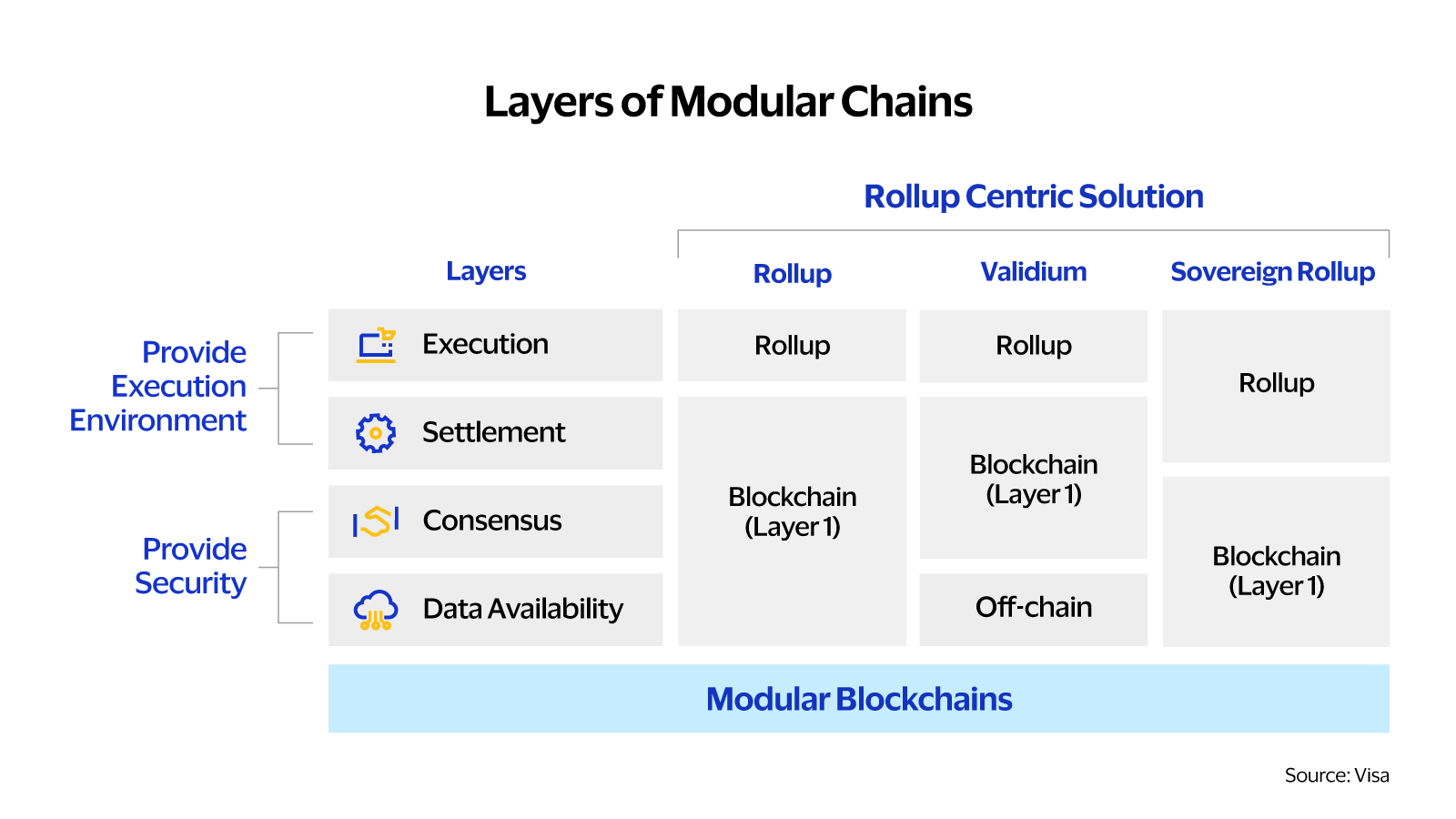
The first popular method, Rollups, is an innovative approach within modular blockchains aimed at improving the scalability of monolithic blockchains by prioritizing decentralization and security. Rollups are closely tied to the parent chain, acting as an extension designed to increase throughput. Rollups necessitate fraud or validity proofs, a mechanism for permissionless transaction insertion, and the capability to post the net results of their blocks onto another blockchain, namely the parent chain. This process is accomplished by synchronizing data between Layer 1 and Layer 2 smart contracts on blockchains. Rollups can act as execution layers while depending on the base layer for other functions, such as data availability, consensus and settlement.
The second method, known as Validium, is a distinct rollup variant that processes transactions off-chain before submitting them, along with a validity proof, to the parent chain. While off-chain data availability involves trade-offs, it can yield significant scalability improvements since its objective is to optimize data availability using an off-chain data availability layer, representing a unique approach within modular blockchains. A Validium chain employs a data availability committee or a network of proof-of-stake validators, called a "data availability network," to store off-chain data outside the parent chain.
The third method, referred to as Sovereign Rollups, operates differently from traditional rollups as it does not rely on Layer 1 smart contracts to validate and append blocks to the canonical chain. Instead, blocks are published as raw data directly onto the rollup, and nodes within the rollup are responsible for determining the correct chain by verifying the local fork choice rule. Sovereign rollups shift settlement responsibility from Layer 1 to the rollup itself. A limitation of sovereign rollups is their inability to enable synchronous cross-rollup communication since they settle on separate settlement chains, i.e., themselves. Blockchains like Celestia exemplify those utilizing sovereign rollups.⁶
Comparison of monolithic and modular blockchain designs
In monolithic blockchains, the blockchain trilemma dictates that scalability comes at the expense of either decentralization or security. |
Modular blockchains are designed to mitigate some scalability issues by optimizing relevant modules for speed and execution. |
|
Adaptability and Flexibility |
Rigid structure in monolithic blockchains may result in limited adaptability, restricting customization and response to system overloads. |
Modular blockchains boast high adaptability with specialized chains for specific tasks, offering greater design flexibility. |
System Complexity |
Monolithic blockchains are less complex, featuring a single-system architecture, which helps simplify understanding but hampers flexibility and scalability. |
Modular blockchains have increased complexity, necessitating advanced mechanisms like data availability sampling and fraud proofs for secure off-chain transitions. |
Security Measures |
Monolithic blockchains help deliver security by allowing node validation of on-chain transactions, with data availability ensured via redundant storage on multiple nodes. |
Modular blockchains have yet-to-be-proven large-scale security, as it depends on module and protocol security; failures in these protocols could cause systemic failure. |
DApp Composability |
Monolithic blockchains can provide high integration, with a straightforward, unified network facilitating easier DApp communication within a single network. |
Modular blockchains exhibit less integration, with transactions passing through separate systems, potentially leading to inefficiencies, security vulnerabilities and limitations in activating global networks through a single smart contract. |
State Bloat Mitigation |
Exponential growth in monolithic blockchains results from transaction accumulation, increasing hardware demands and compromising decentralization. |
Modular blockchains mitigate growth by employing sharding techniques to divide data, enabling more effective pruning and storage, thus minimizing state bloat impact. |
Shared Security Potential |
The blockchain trilemma presents a challenge for monolithic blockchains as they strive to balance security, decentralization and scalability. This balancing act often makes achieving shared security within a multi-chain ecosystem a complex task. |
Modular blockchains can leverage the security of parent chains for specific modules, enabling blockchain Layer 2 solutions to benefit from the decentralization of networks of parent chains like Ethereum (post data sharding). |
Execution Environment |
Monolithic blockchains have limited capabilities due to a shared execution environment. Despite this, applications built on these chains have the advantage of being able to access resources throughout the network via smart contracts if necessary. |
Modular blockchains help offer greater control over application rules through sovereignty, allowing developers to make modifications to the technology stack without seeking approval from external applications. |
Developer Familiarity |
Developers may find monolithic designs easier to work with as there is historical knowledge and experience available for how to use these designs. |
Modular designs are newer and untested, requiring more trial-and-error, expert involvement and the learning of new languages or frameworks under resource constraints, such as Cairo on StarkNet. |
System Upgradability |
Upgrading a monolithic blockchain is challenging, as it requires overhauling the entire system, potentially causing extensive downtime. |
Modular blockchains enable easier upgrades, as they can be improved piece by piece, reducing system failure risk and minimizing downtime. |
Categories of modularity in blockchain design
Figure 5 - Spectrum toward blockchain modular design
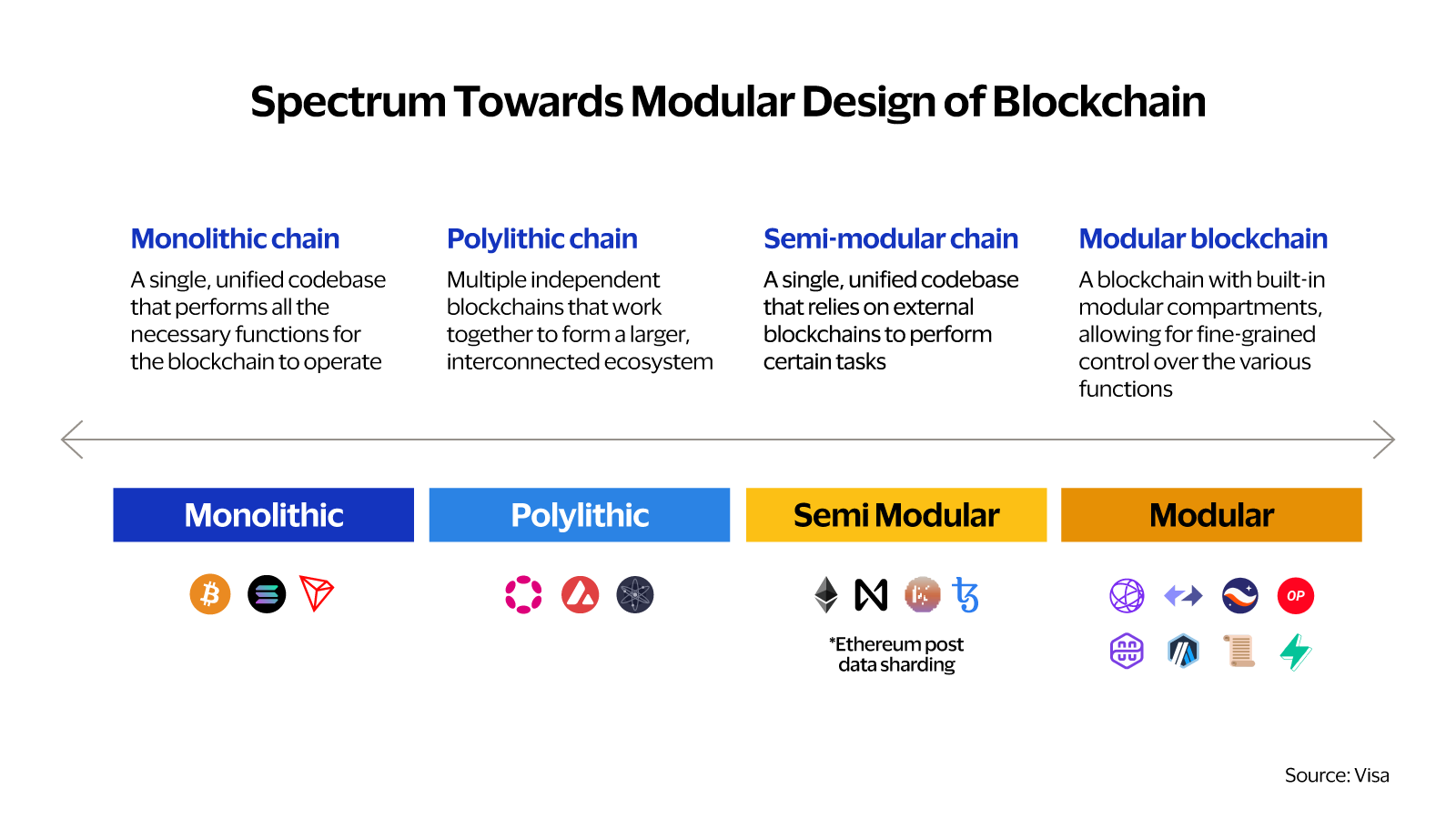
The first category is monolithic, which includes blockchains like Bitcoin, Solana and Tron. These blockchains handle all four core blockchain duties on their own without relying on third-party blockchains.
The second category is polylithic, which includes Cosmos, Avalanche and Polkadot. These blockchains have multichain architectures composed of a base layer with multiple heterogeneous or homogeneous blockchains. They split the single network into multiple parts with subnetworks that are dependent on the single network.
The third category is semi-modular, which includes Ethereum (after data sharding upgrades), Near, Mina and Tezos. These blockchains blend their core functions with external systems for specific tasks. In simpler terms, they manage some operations in-house and delegate others to specialized networks. Importantly, semi-modular blockchains can still execute transactions independently, meaning they can process and validate transactions within their own network.
Finally, the fourth category is modular, which includes chains like Celestia and execution-specific chains like ZkSync, Polygon Hermez, Optimism and Arbitrum. These blockchains are built to handle specific tasks and are unable to handle all the blockchain's functionalities on their own.
The future of modular blockchain design
Blockchain technology has come a long way since its inception with Bitcoin in 2009, and the design and architecture of blockchains have evolved along with it. Initially, the emphasis was solely on being decentralized and secure, but scalability and adaptability to real-world use cases are now important considerations. Thus, there is now a range of modularity in blockchain design. The application and use case's specific requirements decide the ideal blockchain design. While the modular approach provides flexibility, scalability and specialization, it also increases complexity and requires inter-chain coordination. The modularity spectrum will expand as the technology and its use cases evolve, with the rise of innovative design categories. Despite the flourishing modular ecosystem, new monolithic chains are also emerging, such as the Sui Blockchain, which specifically targets scalability as a monolithic solution. The design categories discussed in this article serve as a starting point for understanding the modularity spectrum in blockchain design. We can expect to see more innovation and development in this field of design space in the coming years.
Reach out to Visa Crypto at GDLVisaCryptoResearch@visa.com to learn more about our involvement in the crypto ecosystem and the products we are currently building to help expand our capabilities within blockchain payments. This article is part of a series of articles on blockchain ecosystem developments.
Head over to Visa Crypto Thought Leadership for more consumer insights, best practices and innovative approaches to the blockchain through our research.
Disclaimer
These materials are provided for informational purposes only and should not be relied upon for marketing, legal, regulatory or other advice. Recommendations must be independently evaluated in light of your specific business needs and any applicable laws and regulations. Visa is not responsible for your use of these materials, best practice recommendations or other information, including errors of any kind, contained in this document. Readers are encouraged to seek the advice of a competent professional prior to implementing recommendations based on the materials. All brand names, logos and/or trademarks are the property of their respective owners, are used for identification purposes only and do not necessarily imply product endorsement or affiliation with Visa.
Footnotes
- A comprehensive overview of enterprise blockchain by Visa. Accessed 1 June. 2023.
- “Why Sharding Is Great: Demystifying the Technical Properties” /general/2021/04/07/sharding.html. Accessed 1 June. 2023.
- “Blockchain.com | Charts - Transaction Rate per Second.” Blockchain.com | https://www.blockchain.com/explorer/charts/transactions-per-second. Accessed 1 June. 2023.
- etherscan.io. “Ethereum (ETH) Blockchain Explorer.” etherscan.io. Accessed 1 June. 2023.
- “Explorer | Solana.” Explorer | Solana, explorer.solana.com. Accessed 1 June. 2023.
- “Celestia-Build Modular. | Build Modular.” docs.celestia.org. Accessed 1 June. 2023.
Glossary
- Layer 1: The main blockchain network layer where transactions are processed and validated.
- Layer 2: Additional protocols built on top of Layer 1 to improve scalability and functionality.
- DApp: A software application that uses smart contracts on a blockchain network.
- State Bloat: The growth of data storage required to maintain a blockchain network, which can affect costs and processing times.
- Shared Security: A security model where multiple blockchains share the same security system of an interconnected network to enhance security.
- Execution Environment: A virtual machine where smart contracts or DApps are executed on a blockchain network, ensuring isolation and consistency.